|
|
The Grandeur of Huế Citadel
 The imposing main entrance gate, indeed a veritable palace in its own right, of the Imperial City is called the Noon Gate (Ngọ Môn) although the founding geomancers actually aligned the palace to the River Huòng somewhat to the east of south
The
Nguyễn dynasty
The imposing main entrance gate, indeed a veritable palace in its own right, of the Imperial City is called the Noon Gate (Ngọ Môn) although the founding geomancers actually aligned the palace to the River Huòng somewhat to the east of south
The
Nguyễn dynasty
 came to rule Vietnam at the start of the 1800s and moved Vietnam's capital to Huế. They at once set about establishing a palace, or
more a park of palaces,
came to rule Vietnam at the start of the 1800s and moved Vietnam's capital to Huế. They at once set about establishing a palace, or
more a park of palaces,
 on a scale to rival the old adversary China, and specifically with its Forbidden City in Beijing. Work started in 1804 and continued for three decades. The citadel comprised palaces, gardens, lakes, and temples
all laid out within three sets of concentric walls. The outer walls of the Citadel measure two kilometres by two kilometres, within which lies the
Imperial City
on a scale to rival the old adversary China, and specifically with its Forbidden City in Beijing. Work started in 1804 and continued for three decades. The citadel comprised palaces, gardens, lakes, and temples
all laid out within three sets of concentric walls. The outer walls of the Citadel measure two kilometres by two kilometres, within which lies the
Imperial City
 with a wall and moat 2.5 kilometres long, and then inside that is the Forbidden City reserved for the royal family. This page concerns the grand scale of the Imperial City, and next week's more at detail.
with a wall and moat 2.5 kilometres long, and then inside that is the Forbidden City reserved for the royal family. This page concerns the grand scale of the Imperial City, and next week's more at detail.
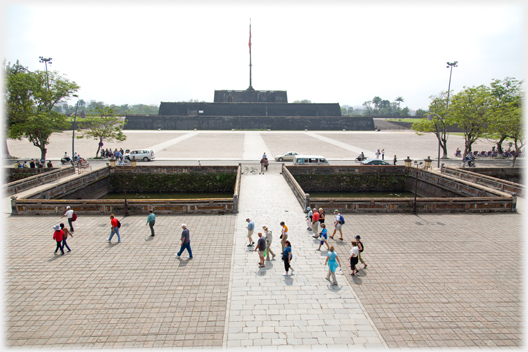 The Ngọ Môn Square occupies the ground in front of the entrance pavilion, this is the view from that gate towards the flag tower which dominates the square being nearly 40 metres high. Flags are very important in Vietnam, it is noticeable how they are found...
The Ngọ Môn Square occupies the ground in front of the entrance pavilion, this is the view from that gate towards the flag tower which dominates the square being nearly 40 metres high. Flags are very important in Vietnam, it is noticeable how they are found...
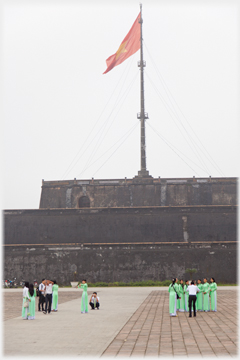 ...outside every house, proudly on the Citadel in Hà Nội, and with spectacular ostentation at the the
country's northern apex
...outside every house, proudly on the Citadel in Hà Nội, and with spectacular ostentation at the the
country's northern apex
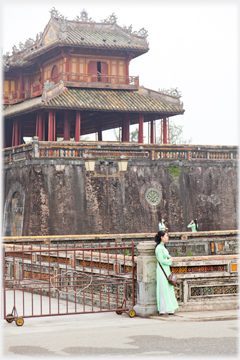 The Entrance Pavilion's east end with model tourist
The Entrance Pavilion's east end with model tourist
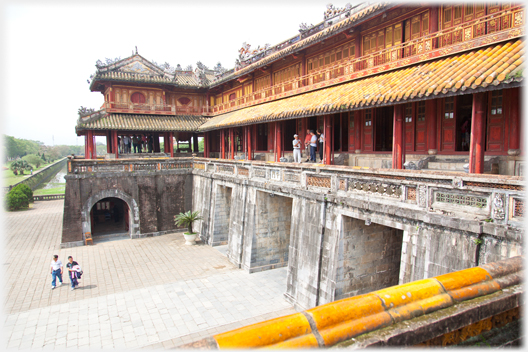 The first floor gallery of the Ngọ Môn from where the royalty could receive visitors; a place suitable for the dignity of the new dynasty
The first floor gallery of the Ngọ Môn from where the royalty could receive visitors; a place suitable for the dignity of the new dynasty
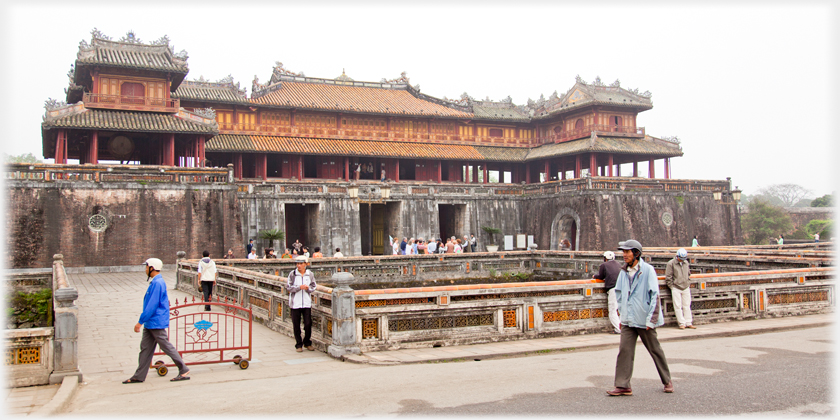 The moat in front of the main entrance is crossed by two two bridges, after which the visitor enters the Imperial City through one of three tunnels
The moat in front of the main entrance is crossed by two two bridges, after which the visitor enters the Imperial City through one of three tunnels
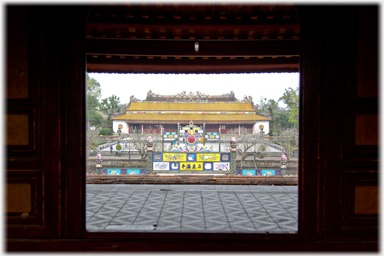 The view from the Ngọ Môn entrance inwards towards the first of the palaces - Thái Hoà
The view from the Ngọ Môn entrance inwards towards the first of the palaces - Thái Hoà
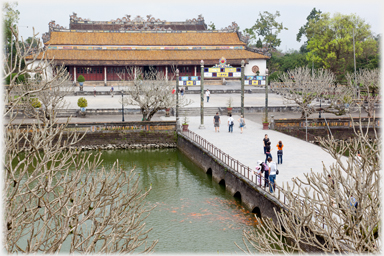 Between the entrance gate and the Thái Hoà Palace is the Thái Dịch Lake crossed with this bridge
Between the entrance gate and the Thái Hoà Palace is the Thái Dịch Lake crossed with this bridge
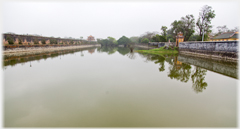 On the north side of the Imperial City lies the Kim Thủy Moat
On the north side of the Imperial City lies the Kim Thủy Moat
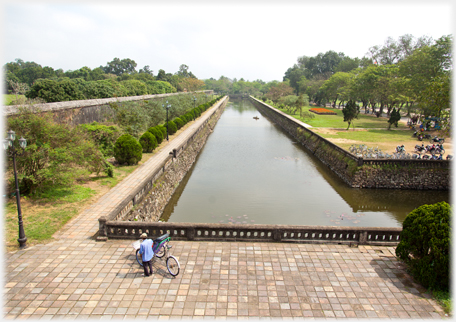 Around the two and a half kilometre perimeter of the Imperial City runs a moat which, together with the 4 metre high wall, was actually probably built mostly with seclusion in mind
Around the two and a half kilometre perimeter of the Imperial City runs a moat which, together with the 4 metre high wall, was actually probably built mostly with seclusion in mind
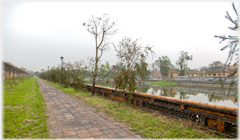 The moat, no longer needed for defence, is able to offer pleasant walkways
The moat, no longer needed for defence, is able to offer pleasant walkways
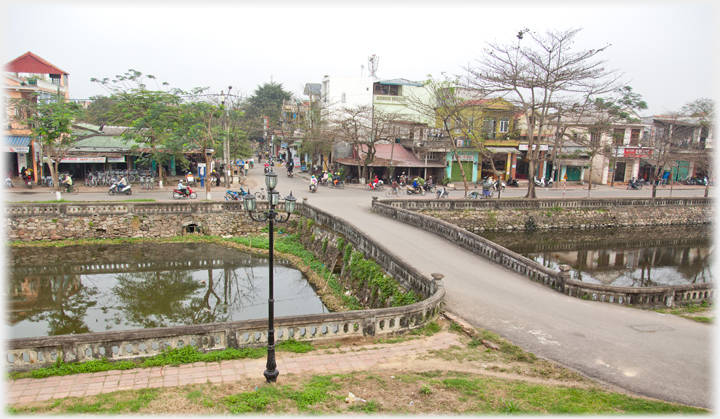 The view over the Phùng Hung Bridge, which leads from the Imperial City to the outer part of the Citadel, across the moat
The view over the Phùng Hung Bridge, which leads from the Imperial City to the outer part of the Citadel, across the moat
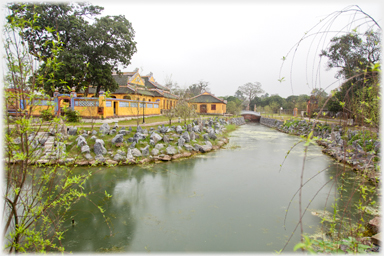 The Trường Sanh Palace with its own mini-moat
The Trường Sanh Palace with its own mini-moat
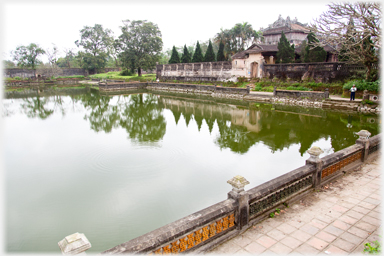 Thái Bình Lâu Pavilion by the Ngọc Dịch Lake
Thái Bình Lâu Pavilion by the Ngọc Dịch Lake
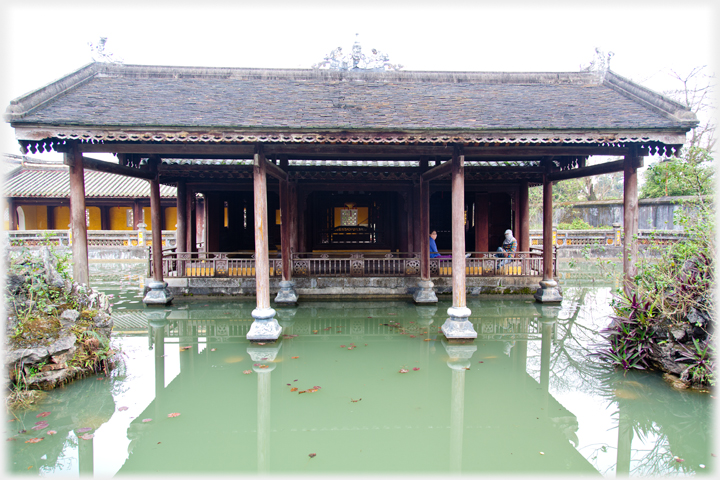 The Trường Du Pavilion, with its columns reflected in the pool (sometimes called the Lotus Pool) is reminiscent of the older and far away
Chehel Sotoun Palace
in Isfahan
The Trường Du Pavilion, with its columns reflected in the pool (sometimes called the Lotus Pool) is reminiscent of the older and far away
Chehel Sotoun Palace
in Isfahan
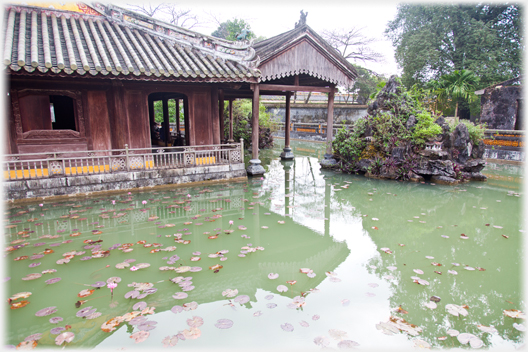 The Trường Du Pavilion is attached to the Diên Thọ Palace
The Trường Du Pavilion is attached to the Diên Thọ Palace
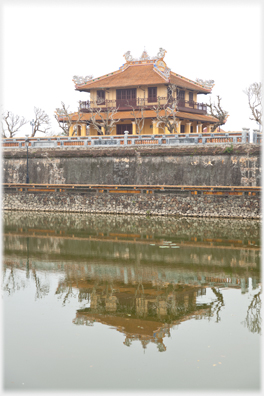 The Hòa Bình Gate sits at the centre of the north-western wall
Almost exactly sixty years ago, at Tết, the Americans bombed the 160 buildings of the Imperial City and reduced them to the 10 you can now see...
...this residue seems like an endless complex of Palaces and Temples, but it represents less than 10% of the original!
The Hòa Bình Gate sits at the centre of the north-western wall
Almost exactly sixty years ago, at Tết, the Americans bombed the 160 buildings of the Imperial City and reduced them to the 10 you can now see...
...this residue seems like an endless complex of Palaces and Temples, but it represents less than 10% of the original!
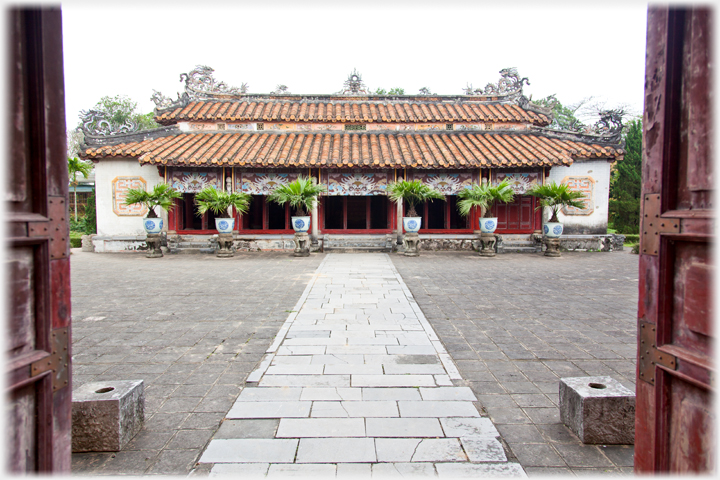 The Hưng Miểu Temple Courtyard
The Hưng Miểu Temple Courtyard
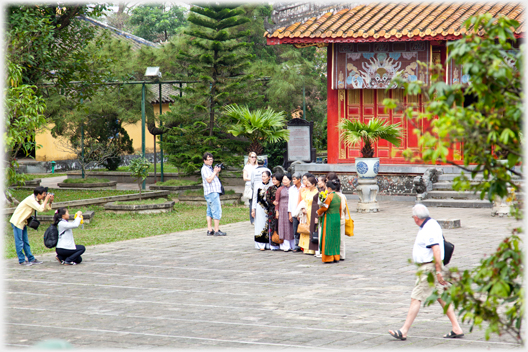 A group of Vietnamese tourists, some women in the traditional 'long dress', relishing being captured near the Hưng Miếu Temple
A group of Vietnamese tourists, some women in the traditional 'long dress', relishing being captured near the Hưng Miếu Temple
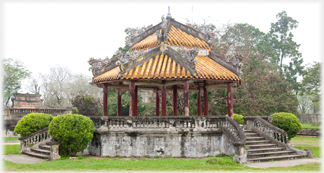 A gazebo in a one time formal garden
A gazebo in a one time formal garden
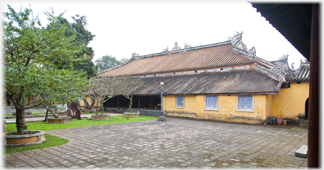 Rear of the Diên Thọ (Prolonged Life) Palace
Rear of the Diên Thọ (Prolonged Life) Palace
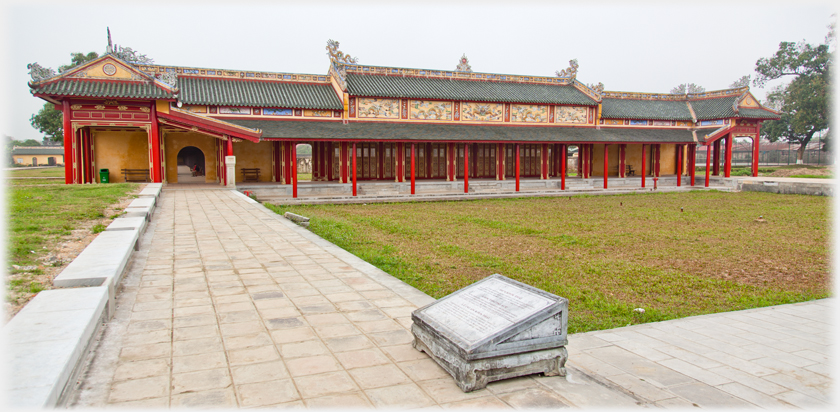 The beautifully restored Khôn Thái Palace, which shines in gold and red even on a grey day, was one of the earliest buildings, it was built for the Emperor's wife
The beautifully restored Khôn Thái Palace, which shines in gold and red even on a grey day, was one of the earliest buildings, it was built for the Emperor's wife
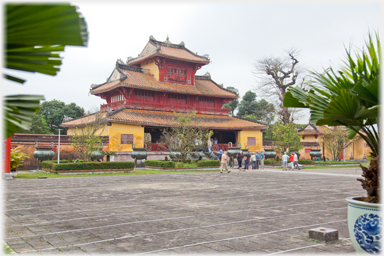 The Hiển Lâm Pavilion
The Hiển Lâm Pavilion
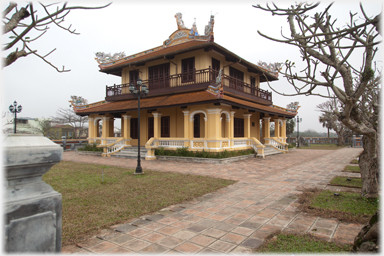 The south side of the Hòa Bình Gate
The south side of the Hòa Bình Gate
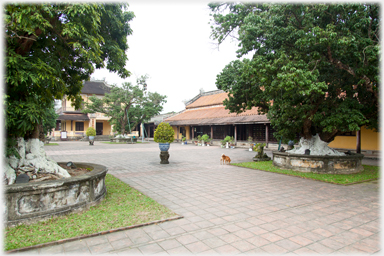 The Diên Thọ Palace and courtyard
The Diên Thọ Palace and courtyard
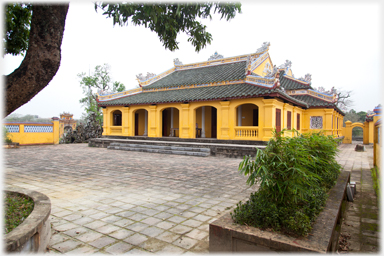 The Trường Sanh Palace
The Trường Sanh Palace
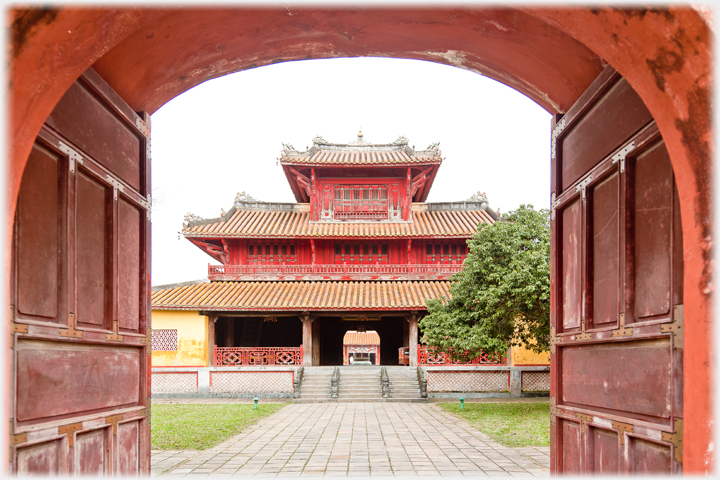 The Hiển Lâm Pavilion
The next page
stays in the Imperial City and shows more of the details of workmanship - a patronage which helped develop the craftsmanship of the age.
The Hiển Lâm Pavilion
The next page
stays in the Imperial City and shows more of the details of workmanship - a patronage which helped develop the craftsmanship of the age.
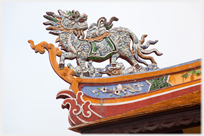

Saturday 10th February 2018
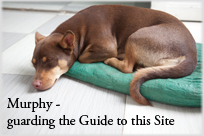
Go to the Picture Posting contents page
Return to the top
|
|
 The imposing main entrance gate, indeed a veritable palace in its own right, of the Imperial City is called the Noon Gate (Ngọ Môn) although the founding geomancers actually aligned the palace to the River Huòng somewhat to the east of south
The
Nguyễn dynasty
The imposing main entrance gate, indeed a veritable palace in its own right, of the Imperial City is called the Noon Gate (Ngọ Môn) although the founding geomancers actually aligned the palace to the River Huòng somewhat to the east of south
The
Nguyễn dynasty
 came to rule Vietnam at the start of the 1800s and moved Vietnam's capital to Huế. They at once set about establishing a palace, or
more a park of palaces,
came to rule Vietnam at the start of the 1800s and moved Vietnam's capital to Huế. They at once set about establishing a palace, or
more a park of palaces,
 on a scale to rival the old adversary China, and specifically with its Forbidden City in Beijing. Work started in 1804 and continued for three decades. The citadel comprised palaces, gardens, lakes, and temples
all laid out within three sets of concentric walls. The outer walls of the Citadel measure two kilometres by two kilometres, within which lies the
Imperial City
on a scale to rival the old adversary China, and specifically with its Forbidden City in Beijing. Work started in 1804 and continued for three decades. The citadel comprised palaces, gardens, lakes, and temples
all laid out within three sets of concentric walls. The outer walls of the Citadel measure two kilometres by two kilometres, within which lies the
Imperial City
 with a wall and moat 2.5 kilometres long, and then inside that is the Forbidden City reserved for the royal family. This page concerns the grand scale of the Imperial City, and next week's more at detail.
with a wall and moat 2.5 kilometres long, and then inside that is the Forbidden City reserved for the royal family. This page concerns the grand scale of the Imperial City, and next week's more at detail.
 The Ngọ Môn Square occupies the ground in front of the entrance pavilion, this is the view from that gate towards the flag tower which dominates the square being nearly 40 metres high. Flags are very important in Vietnam, it is noticeable how they are found...
The Ngọ Môn Square occupies the ground in front of the entrance pavilion, this is the view from that gate towards the flag tower which dominates the square being nearly 40 metres high. Flags are very important in Vietnam, it is noticeable how they are found...
 ...outside every house, proudly on the Citadel in Hà Nội, and with spectacular ostentation at the the
country's northern apex
...outside every house, proudly on the Citadel in Hà Nội, and with spectacular ostentation at the the
country's northern apex
 The Entrance Pavilion's east end with model tourist
The Entrance Pavilion's east end with model tourist
 The first floor gallery of the Ngọ Môn from where the royalty could receive visitors; a place suitable for the dignity of the new dynasty
The first floor gallery of the Ngọ Môn from where the royalty could receive visitors; a place suitable for the dignity of the new dynasty
 The moat in front of the main entrance is crossed by two two bridges, after which the visitor enters the Imperial City through one of three tunnels
The moat in front of the main entrance is crossed by two two bridges, after which the visitor enters the Imperial City through one of three tunnels
 The view from the Ngọ Môn entrance inwards towards the first of the palaces - Thái Hoà
The view from the Ngọ Môn entrance inwards towards the first of the palaces - Thái Hoà
 Between the entrance gate and the Thái Hoà Palace is the Thái Dịch Lake crossed with this bridge
Between the entrance gate and the Thái Hoà Palace is the Thái Dịch Lake crossed with this bridge
 On the north side of the Imperial City lies the Kim Thủy Moat
On the north side of the Imperial City lies the Kim Thủy Moat
 Around the two and a half kilometre perimeter of the Imperial City runs a moat which, together with the 4 metre high wall, was actually probably built mostly with seclusion in mind
Around the two and a half kilometre perimeter of the Imperial City runs a moat which, together with the 4 metre high wall, was actually probably built mostly with seclusion in mind
 The moat, no longer needed for defence, is able to offer pleasant walkways
The moat, no longer needed for defence, is able to offer pleasant walkways
 The view over the Phùng Hung Bridge, which leads from the Imperial City to the outer part of the Citadel, across the moat
The view over the Phùng Hung Bridge, which leads from the Imperial City to the outer part of the Citadel, across the moat
 The Trường Sanh Palace with its own mini-moat
The Trường Sanh Palace with its own mini-moat
 Thái Bình Lâu Pavilion by the Ngọc Dịch Lake
Thái Bình Lâu Pavilion by the Ngọc Dịch Lake
 The Trường Du Pavilion, with its columns reflected in the pool (sometimes called the Lotus Pool) is reminiscent of the older and far away
Chehel Sotoun Palace
in Isfahan
The Trường Du Pavilion, with its columns reflected in the pool (sometimes called the Lotus Pool) is reminiscent of the older and far away
Chehel Sotoun Palace
in Isfahan
 The Trường Du Pavilion is attached to the Diên Thọ Palace
The Trường Du Pavilion is attached to the Diên Thọ Palace
 The Hòa Bình Gate sits at the centre of the north-western wall
Almost exactly sixty years ago, at Tết, the Americans bombed the 160 buildings of the Imperial City and reduced them to the 10 you can now see...
...this residue seems like an endless complex of Palaces and Temples, but it represents less than 10% of the original!
The Hòa Bình Gate sits at the centre of the north-western wall
Almost exactly sixty years ago, at Tết, the Americans bombed the 160 buildings of the Imperial City and reduced them to the 10 you can now see...
...this residue seems like an endless complex of Palaces and Temples, but it represents less than 10% of the original!
 The Hưng Miểu Temple Courtyard
The Hưng Miểu Temple Courtyard
 A group of Vietnamese tourists, some women in the traditional 'long dress', relishing being captured near the Hưng Miếu Temple
A group of Vietnamese tourists, some women in the traditional 'long dress', relishing being captured near the Hưng Miếu Temple
 A gazebo in a one time formal garden
A gazebo in a one time formal garden
 Rear of the Diên Thọ (Prolonged Life) Palace
Rear of the Diên Thọ (Prolonged Life) Palace
 The beautifully restored Khôn Thái Palace, which shines in gold and red even on a grey day, was one of the earliest buildings, it was built for the Emperor's wife
The beautifully restored Khôn Thái Palace, which shines in gold and red even on a grey day, was one of the earliest buildings, it was built for the Emperor's wife
 The Hiển Lâm Pavilion
The Hiển Lâm Pavilion
 The south side of the Hòa Bình Gate
The south side of the Hòa Bình Gate
 The Diên Thọ Palace and courtyard
The Diên Thọ Palace and courtyard
 The Trường Sanh Palace
The Trường Sanh Palace
 The Hiển Lâm Pavilion
The next page
stays in the Imperial City and shows more of the details of workmanship - a patronage which helped develop the craftsmanship of the age.
The Hiển Lâm Pavilion
The next page
stays in the Imperial City and shows more of the details of workmanship - a patronage which helped develop the craftsmanship of the age.


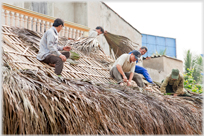 The last page was about the roofing of our cafe
The last page was about the roofing of our cafe
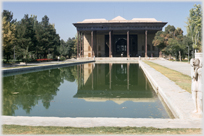 A page with a grand palace in Isfahan, Iran
A page with a grand palace in Isfahan, Iran
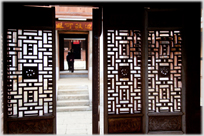 Go to a page on the tiny Đồng Văn palace in the far north of Vietnam
Go to a page on the tiny Đồng Văn palace in the far north of Vietnam
